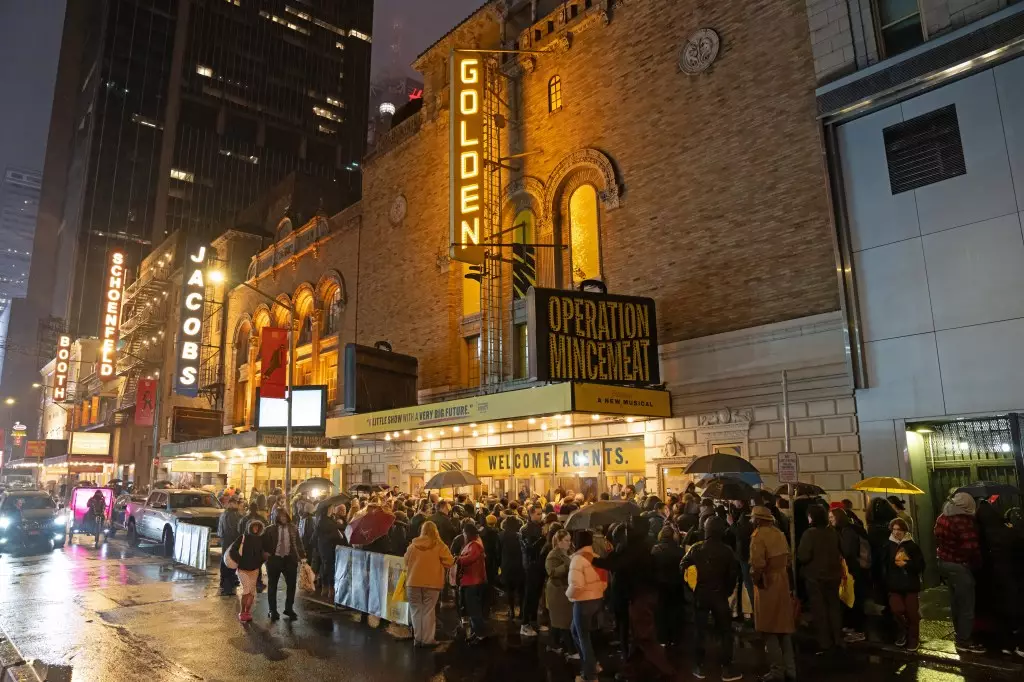Broadway is a dynamic playground where narratives of triumph and loss coexist within the vibrant lights of the stage. As new productions surface and established favorites close their curtains, the ebb and flow of ticket sales and audience engagement dictate the pulse of New York City’s theatrical scene. Recently, the arrival of “Operation Mincemeat” has added intrigue to Broadway’s landscape, despite a somewhat unconventional start.
“Operation Mincemeat,” a musical that has garnered significant attention even before its arrival, sold out its initial preview at the John Golden Theatre, raking in an impressive $111,459. However, a peculiar hiccup marred its debut; the show’s marquee title was not illuminated. The delay in lighting was attributed to logistic challenges stemming from the ongoing fallout between the U.S. and China, eliminating the captivating glow that typically heralds a new Broadway offering. This oddity only fueled the buzz surrounding the production, as a waitlist of about 500 eager fans, dubbed “Mincefluencers,” underscores the show’s popularity. These dedicated fans, many traveling from the UK, highlight the international allure that Broadway holds, proving that the demand for theatrical experiences transcends borders.
What stands out amid the challenges is how the show has managed to captivate public interest. With its name in dim lights but its heart ablaze with energetic performances, “Operation Mincemeat” demonstrates that substantive artistry can thrive under adverse conditions.
The departure of notable productions like “Romeo + Juliet” and “All In: Comedy About Love” paints a vivid picture of Broadway’s transitory nature. “Romeo + Juliet,” headlined by burgeoning stars Kit Connor and Rachel Zegler, concluded its run after a robust final week grossing $1,477,353. This success exemplifies how high-profile talent can drive ticket sales, particularly when the chemistry between leads resonates with audiences. With an average ticket price hitting $225.07, it underscores the reality that audiences are willing to invest heavily for compelling storytelling.
Similarly, “All In: Comedy About Love” not only wrapped up successfully, with a gross of $1,526,260 that showcased a substantial increase week-over-week, but it also announced the launch of a sequel, “All Out: Comedy About Life.” This strategic move towards a companion show reflects producers’ understanding of market dynamics and the importance of audience loyalty. By creating a familial tie to existing works, they harness the goodwill generated from positive experiences.
In contrast, the Manhattan Theatre Club’s “Eureka Day,” a non-profit venture, wrapped its tenure with respectable performance figures, grossing $391,408 and filling 86% of its seats. This dichotomy illustrates the varying economic realities of for-profit Broadway shows versus non-profit endeavors.
On a brighter note, “Redwood,” a new musical headlined by the illustrious Idina Menzel, made its debut with promising numbers. Grossing nearly $1 million across previews and regular performances, the show filled 97% of its seats at the Nederlander Theatre. This impressive start points to Broadway’s continued ability to attract high-caliber talent and fresh narratives, assuring audiences that innovation is at the forefront, even amidst closures.
While some productions like “Cabaret” and “Oh, Mary!” faced challenges in maintaining capacity attendance, the overall health of Broadway remains strong. The total gross for all shows during the week leading into Presidents’ Day jumped to an impressive $32,188,003—a significant increase compared to previous weeks and years. This mixed bag of experiences reflects a resilient theater community that constantly adapts and evolves.
The statistics for the 2024-25 season showcase an encouraging uptick in Broadway’s overall performance, with total gross reaching over $1.3 billion—an impressive 19% rise from the prior year. With total attendance soaring and eager audiences ready to reconnect with live performances, it is clear that Broadway is not merely surviving but thriving. It’s a testament to the enchanting power of theater—a space where stories unfold, cultures converge, and memories are created.
As “Operation Mincemeat” continues to carve out its path on stage, the larger narrative of Broadway remains one of resilience and creativity, promising vibrant stories that will captivate audiences for years to come.

